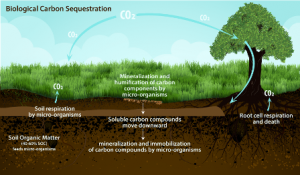India’s Rural Job Scheme Could Also Help Sequester Carbon
The Mahatma Gandhi National Rural Employment Guarantee Scheme (MGNREGS) launched in 2006 to ensure livelihood security of rural people can also help India meet its target to create additional carbon sink to the extent of 2.5 to 3 billion tonnes equivalent of carbon dioxide by2030, through an improved forest and tree covers, as per the Paris agreement on Climate Change.
ensure livelihood security of rural people can also help India meet its target to create additional carbon sink to the extent of 2.5 to 3 billion tonnes equivalent of carbon dioxide by2030, through an improved forest and tree covers, as per the Paris agreement on Climate Change.
This has been demonstrated by a study conducted by the Bengaluru-based Indian Institute of Science (IISc). It has been estimated that the scheme may have helped capture a total carbon of 102 million tonnes equivalent in 2017-18 through plantations and soil quality improvement works and that the annual capacity for carbon sequestration could steadily increase to about 249 million tonnes of carbon dioxide equivalent by 2030.
The study calculated carbon sequestration by assessing biomass in plantations and carbon stored in the soil of work sites in villages across the country except for two agro-ecological zones — Western Himalayas, Ladakh plateau and north Kashmir; and Andaman and Nicobar, and Lakshadweep islands.
Also Read : Study to Help Develop Better Treatment for Blood-Related Disorders
The researchers found that drought-proofing activities, including tree plantations, forest restoration and grassland development, captured the maximum carbon,accounting for a little over 40% of the total carbon sequestration under MGNREGS.
The carbon captured from drought-proofing ranged from 0.29 tonne per hectare to 4.50 tonne per hectare per year depending on the region. Land development activities, including earthen bunding, stone bunding and land leveling, captured 0.1 tonne per hectare per year to 1.97 tonne per hectare per year while minor irrigation sequestered 0.08 to 1.93 tonne per hectare per year.
The study covered 32 districts, which accounted for about five per cent of the total number of districts in India. In each district, two blocks were selected and in each block, three villages were shortlisted based on their population (small, medium, and large).
In a research published in the science journal PLOS One, the scientists noted, “The activities implemented under MGNREGS become all the more important as the forest sector alone may not be able to meet the NDC carbon sink target of 2.5 to 3 billion tonnes of CO2 by 2030”.
They have suggested incorporation of tree planting; especially fruit and fodder yielding trees into resource management activitiesunder MGNREGS.This will generate alternate income and livelihood sources for people while carbon sequestration will be a co-benefit. Periodic monitoring and reporting of the carbon sequestration benefits will be required, which is also a requirement for adaptation communication under Article 7 of the Paris Agreement, they said.
